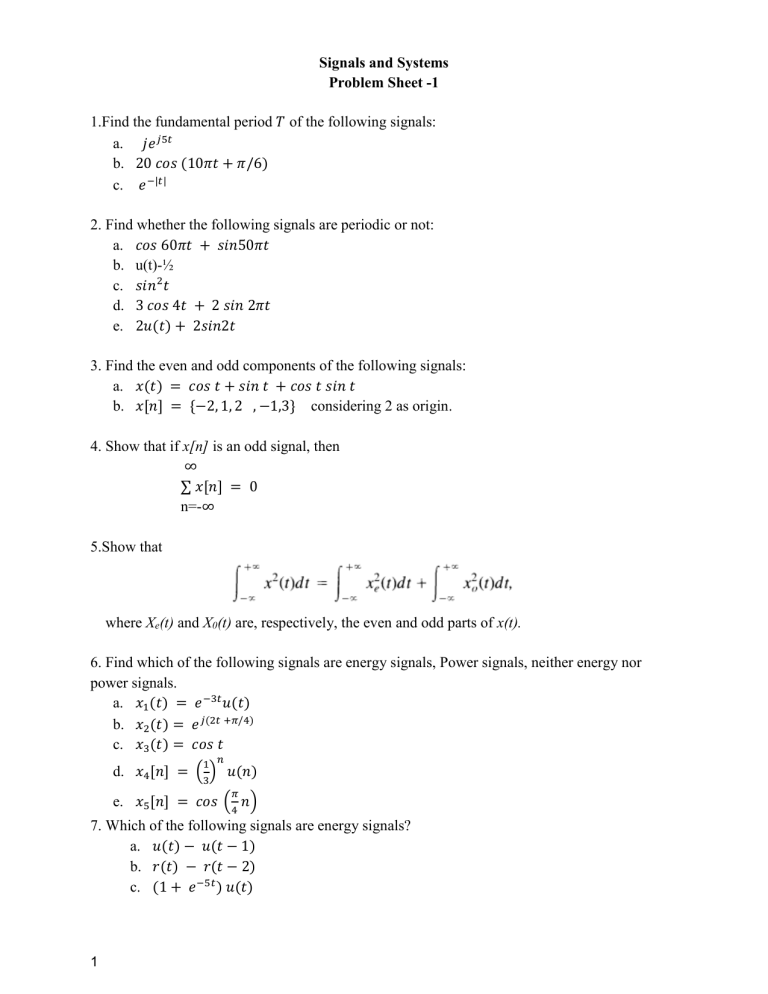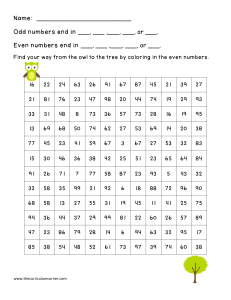
Signals and Systems
Problem Sheet -1
1.Find the fundamental period 𝑇 of the following signals:
a. 𝑗𝑒 𝑗5𝑡
b. 20 𝑐𝑜𝑠 (10𝜋𝑡 + 𝜋/6)
c. 𝑒 −|𝑡|
2. Find whether the following signals are periodic or not:
a. 𝑐𝑜𝑠 60𝜋𝑡 + 𝑠𝑖𝑛50𝜋𝑡
b. u(t)-½
c. 𝑠𝑖𝑛2 𝑡
d. 3 𝑐𝑜𝑠 4𝑡 + 2 𝑠𝑖𝑛 2𝜋𝑡
e. 2𝑢(𝑡) + 2𝑠𝑖𝑛2𝑡
3. Find the even and odd components of the following signals:
a. 𝑥(𝑡) = 𝑐𝑜𝑠 𝑡 + 𝑠𝑖𝑛 𝑡 + 𝑐𝑜𝑠 𝑡 𝑠𝑖𝑛 𝑡
b. 𝑥[𝑛] = {−2, 1, 2 , −1,3} considering 2 as origin.
4. Show that if x[n] is an odd signal, then
∞
∑ 𝑥[𝑛] = 0
n=-∞
5.Show that
where Xe(t) and X0(t) are, respectively, the even and odd parts of x(t).
6. Find which of the following signals are energy signals, Power signals, neither energy nor
power signals.
a. 𝑥1 (𝑡) = 𝑒 −3𝑡 𝑢(𝑡)
b. 𝑥2 (𝑡) = 𝑒 𝑗(2𝑡 +𝜋/4)
c. 𝑥3 (𝑡) = 𝑐𝑜𝑠 𝑡
1 𝑛
d. 𝑥4 [𝑛] = (3) 𝑢(𝑛)
𝜋
e. 𝑥5 [𝑛] = 𝑐𝑜𝑠 (4 𝑛)
7. Which of the following signals are energy signals?
a. 𝑢(𝑡) − 𝑢(𝑡 − 1)
b. 𝑟(𝑡) − 𝑟(𝑡 − 2)
c. (1 + 𝑒 −5𝑡 ) 𝑢(𝑡)
1
8.For each of the following determine whether the following systems are time-invariant or timevariant:
a. 𝑦(𝑡) = 2𝑡 2 𝑥(𝑡)
b. 𝑦(𝑡) = 3𝑒 3𝑥(𝑡)
c. 𝑦(𝑡) = 𝑥(𝑡) + 𝑡𝑥(𝑡 − 1)
d. 𝑦(𝑡) = sin[𝑥(𝑡)]
e. 𝑦(𝑡) = 𝑥(2𝑡) + 3
9.For each of the following determine whether the following systems are linear or non-linear:
a. 𝑦[𝑛] = 2𝑥[𝑛] + 3
b. 𝑦(𝑡) = 𝑥 2 (𝑡)
c. 𝑦[𝑛] = 𝑥 2 [𝑛] − 𝑥[𝑛 − 1]𝑥[𝑛 + 1]
𝑑𝑦
d. 𝑑𝑡 − 3𝑦(𝑡) = 𝑥(𝑡)
e. 𝑦[𝑛] = 𝑛𝑥[𝑛]
10.For each of the following determine whether the following systems are invertible or not:
a. 𝑦(𝑡) = 𝑠𝑖𝑛𝑡. 𝑥(𝑡)
b. 𝑦(𝑡) = 3 + 3𝑥(𝑡)
c. 𝑦(𝑡) = 5𝑥 2 (𝑡)
d. 𝑦(𝑡) = [1 + (−1)𝑛 ]𝑥[𝑛]
e. 𝑦(𝑡) = |𝑥(𝑡)|
11. Consider three systems with the following input-output relationships:
Suppose that these systems are connected in series as depicted in Figure below. Find the inputoutput relationship for the overall interconnected system. Is this system linear? Is it time
invariant?
12. Determine whether the following systems are memory / memoryless. Also evaluate the
causal property of these systems.
2
13. Determine and sketch the even and odd parts of the signals depicted in figure below.
14. A continuous-time signal x(t) is shown in Figure. Sketch and label carefully each of the
following signals:
3

![ )] (](http://s2.studylib.net/store/data/010418727_1-2ddbdc186ff9d2c5fc7c7eee22be7791-300x300.png)



